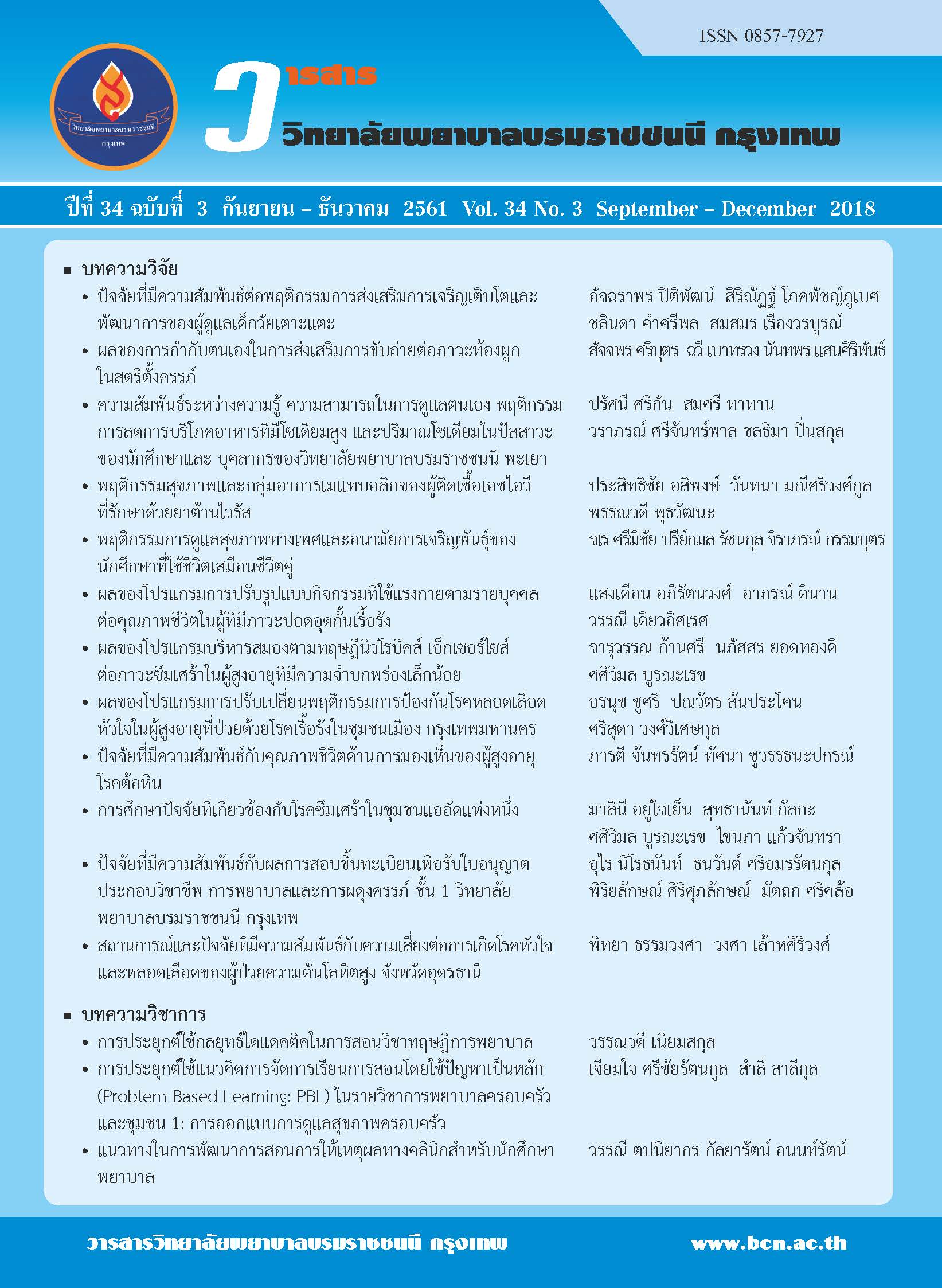ความสัมพันธ์ระหว่างความรู้ ความสามารถในการดูแลตนเอง พฤติกรรมการลดการบริโภคอาหารที่มีโซเดียมสูง และปริมาณโซเดียมในปัสสาวะของนักศึกษาและบุคลากรของวิทยาลัยพยาบาลบรมราชชนนี พะเยา
คำสำคัญ:
ความรู้ ความสามารถในการดูแลตนเอง, พฤติกรรม, โซเดียมในปัสสาวะ, อาหารที่มีโซเดียมสูงบทคัดย่อ
การวิจัยแบบบรรยายเชิงหาความสัมพันธ์นี้มีวัตถุประสงค์เพื่อศึกษาความสัมพันธ์ระหว่างความรู้ ความสามารถในการดูแลตนเอง พฤติกรรมการลดการบริโภคอาหารที่มีโซเดียมสูง และปริมาณโซเดียมในปัสสาวะ กลุ่มตัวอย่างเป็นนักศึกษา และบุคลากรของวิทยาลัยพยาบาลบรมราชชนนี พะเยา จำนวน 251 คน เก็บข้อมูลโดยใช้แบบบันทึกข้อมูล ส่วนบุคคล แบบประเมินความรู้ ความสามารถในการดูแลตนเองและพฤติกรรมการบริโภคอาหารที่มีปริมาณโซเดียมสูง รวมถึงการตรวจหาปริมาณโซเดียมในปัสสาวะ วิเคราะห์ข้อมูลทั่วไปโดยสถิติเชิงบรรยายและวิเคราะห์ความสัมพันธ์ ระหว่างตัวแปรโดยสถิติค่าสัมประสิทธิ์สหสัมพันธ์เพียร์สัน (Pearson’s product moment correlation)
ผลการวิจัยพบว่ากลุ่มตัวอย่างเป็นผู้หญิง จำนวน 235 (ร้อยละ 93.63) เป็นนักศึกษา จำนวน 200 คน (ร้อยละ 79.68) กลุ่มตัวอย่างจำนวน 206 คน (ร้อยละ 82.07) ซื้ออาหารปรุงสำเร็จจากผู้ขายมารับประทาน และจำนวน 90 คน (ร้อยละ 35.86) ชอบรับประทานอาหารที่มีรสเค็ม ค่าเฉลี่ยของปริมาณโซเดียมในปัสสาวะเท่ากับ 2,432 มิลลิกรัมต่อวัน (Range=345-6,969 มิลลิกรัมต่อวัน, SD= 1,309 มิลลิกรัมต่อวัน) ความรู้มีความสัมพันธ์เชิงบวกกับความสามารถในการดูแลตนเอง และพฤติกรรมในการลดการบริโภคอาหารที่มีปริมาณโซเดียมสูง อย่างมีนัยสำคัญทางสถิติที่ระดับ .01 (r เท่ากับ .342 และ .325 ตามลำดับ) แต่ความรู้ ความสามารถในการดูแลตนเอง และพฤติกรรมการลดการบริโภคอาหารที่มีโซเดียมสูง ไม่มีความสัมพันธ์ทางสถิติที่ระดับ .05 กับปริมาณโซเดียมในปัสสาวะ (r เท่ากับ .069, .043, และ .020 ตามลำดับ) ดังนั้น การจัดกิจกรรมในการรณรงค์การลดการบริโภคอาหารที่มีโซเดียมสูงควรให้ความสำคัญกับการส่งเสริมการปรับเปลี่ยนพฤติกรรมทั้งในระดับบุคคลและในชุมชนไปพร้อมกัน
References
Buranakitjaroen, P., & Phoojaroenchanachai, M. (2013). The prevalence of high sodium intake among hypertensive patients at hypertension clinic, Siriraj Hospital. Journal of the Medical Association of Thailand, 96 Suppl 2, S1-8.
Carbone, L., Johnson, K.C., Huang, Y., Pettinger, M., Thomas, F., Cauley, J., . . . Prentice, R. (2016). Sodium intake and osteoporosis. Findings from the Women's Health Initiative. The Journal of Clinical Endocrinology and Metabolism, 101(4), 1414-1421.
Cavill, N., & Bauman, A. (2004). Changing the way people think about health-enhancing physical activity: Do mass media campaigns have a role? Journal of Sports Science, 22(8), 771-790.
Chen, J. (2010). Sodium sensitivity of blood pressure in Chinese populations. Current Hypertension Reports, 12(2), 127-134.
Chisholm, D., Rehm, J., Van Ommeren, M., & Monteiro, M. (2004). Reducing the global burden of hazardous alcohol use: A comparative cost-effectiveness analysis. Journal of Studies on Alcohol,65(6), 782-793.
Claro, R.M., Linders, H., Ricardo, C.Z., Legetic, B., & Campbell, N. R. (2012). Consumer attitudes, knowledge, and behavior related to salt consumption in sentinel countries of the Americas. Rev Panam Salud Publica, 32(4), 265-273.
De Almeida, R.L., Constancio, J., Vendramini, R.C., Fracasso, J.F., Menani, J.V., & De Luca, L.A., Jr. (2011). Lipopolysaccharide reduces sodium intake and sodium excretion in dehydrated rats. Physiology and Behavior, 102(2), 164-169.
De Stefani, E., Boffetta, P., Ronco, A.L., Deneo-Pellegrini, H., Correa, P., Acosta, G., . . . Silva, C. (2012). Processed meat consumption and risk of cancer: A multisite case–control study in Uruguay. British Journal of Cancer, 107(9), 1584-1588.
De Wardener, H.E., & MacGregor, G.A. (2002). Harmful effects of dietary salt in addition to hypertension. Journal of Human Hypertension, 16(4), 213-223.
Forte, G.C., da Silva, D.R., Hennemann, M.L., Sarmento, R., Almeida, J.C., & de Tarso Roth Dalcin, P. (2017). Diet effects in the asthma treatment: A systematic review. Critical Reviews in Food Science and Nutrition, 58(11),1878-1887.
Fukuda, M., Wakamatsu-Yamanaka, T., Mizuno, M., Miura, T., Tomonari, T., Kato, Y., . . .Kimura, G. (2011). Angiotensin receptor blockers shift the circadian rhythm of blood pressure by suppressing tubular sodium reabsorption. American Journal of Physiology - Renal Physiology, 301(5), F953-957.
Ge, S., Feng, X., Shen, L., Wei, Z., Zhu, Q., & Sun, J. (2012). Association between habitual dietary salt intake and risk of gastric cancer: A systematic review of observational studies. Gastroenterology Research and Practice, 2012, 11.
Grimes, C.A., Riddell, L.J., & Nowson, C.A. (2009). Consumer knowledge and attitudes to salt intake and labelled salt information. Appetite, 53(2), 189-194.
Grimes, C.A., Riddell, L.J., & Nowson, C.A. (2010). The use of table and cooking salt in a sample of Australian adults. Asia Pacific Journal of Clinical Nutrition, 19(2), 256-260.
Haga, M., & Sakata, T. (2010). Daily salt intake of healthy Japanese infants of 3-5 years based on sodium excretion in 24-hour urine. Journal of Nutritional Science and Vitaminology, 56(5), 305-310.
Ho, C.S., Ho, S.C., & Swaminathan, R. (1993). Dietary electrolytes and urinary natriuretic factors.
Internation Journal of Cardiology, 39(1), 1-4.
Land, M.A., Webster, J., Christoforou, A., Johnson, C., Trevena, H., Hodgins, F., . . . Neal, B. (2014).
The association of knowledge, attitudes and behaviours related to salt with 24-hour urinary
sodium excretion. The International Journal of Behavioral Nutrition and Physical Activity, 11(1), 1-8.
Lee, N. V., Miller, P. W., & Buono, M. J. (2010). The effect of spironolactone on sweat and urinary sodium excretion during exercise in humans. Clinical Physiology and Functional Imaging, 30(1), 13-16.
Lifton, R. P., Gharavi, A. G., & Geller, D. S. (2001). Molecular mechanisms of human hypertension. Cell, 104(4), 545-556.
Ohta, Y., Tsuchihashi, T., Arakawa, K., Onaka, U., & Ueno, M. (2007). Prevalence and lifestyle characteristics of hypertensive patients with metabolic syndrome followed at an outpatient clinic in Fukuoka, Japan. Hypertension Research, 30, 1077-1082.
Orem, D.E. (1980). Nursing: Concepts of practice (2nd ed.). New York: McGraw-Hill.
Orem, D.E. (2001). Nursing: Concepts of practice (6th ed.). St. Louis: Mosby.
Pavan De Arruda Camargo, G. M., De Arruda Camargo, L. A., & Abrao Saad, W. (2011). Medial septal area
ANG II receptor subtypes in the regulation of urine and sodium excretion induced by vasopressin. Journal of Renin-Angiotensin-Aldosterone System, 12(1), 23-28.
Peters, Rosalind M., & Templin, Thomas N. (2008). Measuring Blood Pressure Knowledge and Self-Care Behaviors of African Americans. Research in Nursing and Health, 31(6), 543-552. doi: 10.1002/nur.20287
Puska, P. (2002). Successful prevention of non-communicable diseases: 25 year experiences with North Karelia Project in Finland. Public Health Medicine, 4, 5-7.
Sarmugam, R., Worsley, A., & Wang, W. (2013). An examination of the mediating role of salt knowledge and beliefs on the relationship between socio-demographic factors and discretionary salt use:a cross-sectional study. The International Journal of Behavioral Nutrition and Physical Activity,10,(25), 1-9.
Downloads
เผยแพร่แล้ว
How to Cite
ฉบับ
บท
License
บทความที่ได้รับการตีพิมพ์ เป็นลิขสิทธิ์ของวารสารวิจัยสุขภาพและการพยาบาล (วิทยาลัยพยาบาลบรมราชชนนี กรุงเทพ) ไม่สามารถนำไปตีพิมพ์ซ้ำในวารสารฉบับอื่น

















